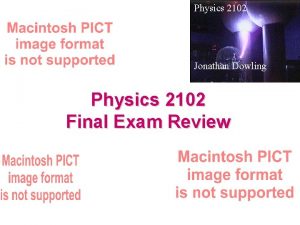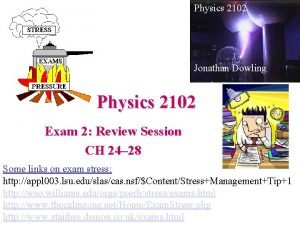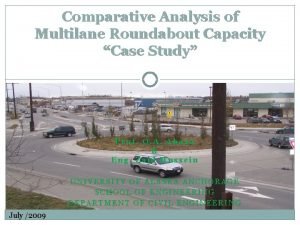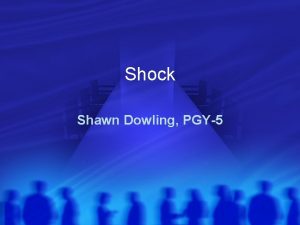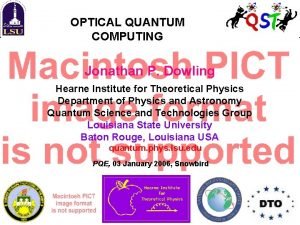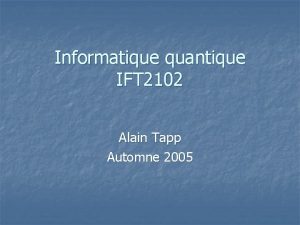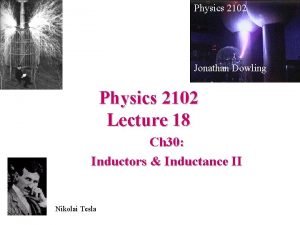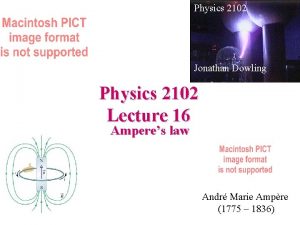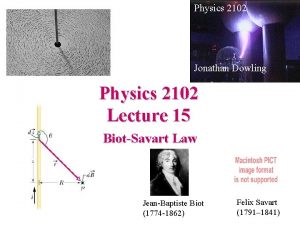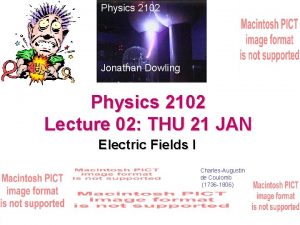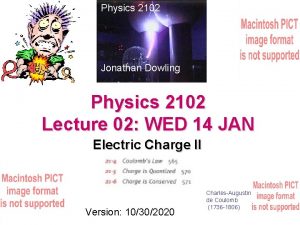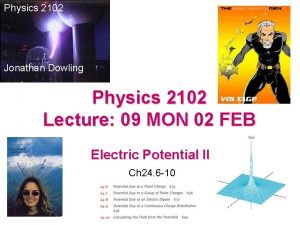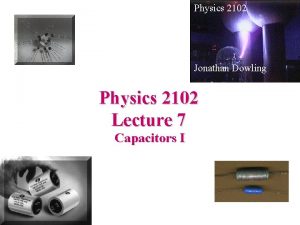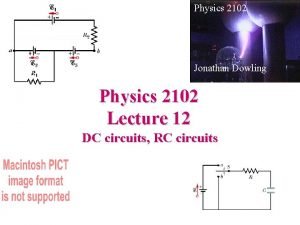Physics 2102 Jonathan Dowling Physics 2102 Lecture 04
















- Slides: 16

Physics 2102 Jonathan Dowling Physics 2102 Lecture: 04 WED 21 JAN Electric Fields II 11/28/2020 Version: 11/28/2020 Michael Faraday (1791 -1867)

Electric Charges and Fields First: Given Electric Charges, We Calculate the Electric Field Using E=kqr/r 3. Charge Produces EField Example: the Electric Field Produced By a Single Charge, or by a Dipole: Second: Given an Electric Field, We Calculate the Forces on Other Charges Using F=q. E Examples: Forces on a Single Charge When Immersed in the Field of a Dipole, Torque on a Dipole When Immersed in an Uniform Electric Field. E-Field Then Produces Force on Another Charge

Continuous Charge Distribution • Thus Far, We Have Only Dealt With Discrete, Point Charges. q • Imagine Instead That a Charge q q Is Smeared Out Over A: q – LINE – AREA – VOLUME • How to Compute the Electric Field E? Calculus!!! q

Charge Density • Useful idea: charge density = q/L • Line of charge: charge per unit length = = q/A • Sheet of charge: charge per unit area = • Volume of charge: charge per unit volume = = q/V

Computing Electric Field of Continuous Charge Distribution • Approach: Divide the Continuous Charge Distribution Into Infinitesimally Small Differential Elements dq • Treat Each Element As a POINT Charge & Compute Its Electric Field • Sum (Integrate) Over All Elements • Always Look for Symmetry to Simplify Calculation! dq = d. L dq = d. S dq = d. V

Differential Form of Coulomb’s Law E-Field at Point q 2 P 1 Differential d. E-Field at Point P 1 P 2 dq 2

Field on Bisector of Charged Rod • Uniform line of charge +q spread over length L • What is the direction of the electric field at a point P on the perpendicular bisector? (a) Field is 0. (b) Along +y (c) Along +x • Choose symmetrically located elements of length dq = dx • x components of E cancel P y x dx a o L dx q

Line of Charge: Quantitative • Uniform line of charge, length L, total charge q • Compute explicitly the magnitude of E at point P on perpendicular bisector • Showed earlier that the net field at P is in the y direction — let’s now compute this! P y a x o L q

Line Of Charge: Field on bisector Distance hypotenuse: d. E P Charge per unit length: a d dx x o L q Adjacent Over Hypotenuse

Line Of Charge: Field on bisector Integrate: Trig Substitution! Point Charge Limit: L << a Line Charge Limit: L >> a Units Check! Coulomb’s Law!

Binomial Approximation from Taylor Series: x<<1

Example — Arc of Charge: Quantitative y • Figure shows a uniformly charged rod of charge -Q bent into a circular arc of radius R, centered at (0, 0). • Compute the direction & magnitude of E at the origin. –Q E 450 x y d. Q = Rdq dq q x = 2 Q/(p. R)

Example : Field on Axis of Charged Disk • A uniformly charged circular disk (with positive charge) • What is the direction of E at point P on the axis? (a) Field is 0 (b) Along +z (c) Somewhere in the x-y plane P z y x

Example : Arc of Charge y • Figure shows a uniformly charged rod of charge –Q bent into a circular arc of radius R, centered at (0, 0). • What is the direction of the electric field at the origin? x (a) Field is 0. (b) Along +y • Choose symmetric elements (c) Along -y • x components cancel

Summary • The electric field produced by a system of charges at any point in space is the force per unit charge they produce at that point. • We can draw field lines to visualize the electric field produced by electric charges. • Electric field of a point charge: E=kq/r 2 • Electric field of a dipole: E~kp/r 3 • An electric dipole in an electric field rotates to align itself with the field. • Use CALCULUS to find E-field from a continuous charge distribution.

 Jonathan dowling
Jonathan dowling Jonathan dowling
Jonathan dowling Dowling roundabout
Dowling roundabout International human resource management dowling 6th edition
International human resource management dowling 6th edition Shawn dowling
Shawn dowling Dowling optical
Dowling optical 01:640:244 lecture notes - lecture 15: plat, idah, farad
01:640:244 lecture notes - lecture 15: plat, idah, farad Form 2102 apostille
Form 2102 apostille Ift-2102
Ift-2102 Nutrition 2102
Nutrition 2102 Nutrition 2102
Nutrition 2102 Nutrition 2102
Nutrition 2102 Physics 101 lecture
Physics 101 lecture Physics 101 lecture notes pdf
Physics 101 lecture notes pdf Phy101 lecture 1
Phy101 lecture 1 Physics waves notes pdf
Physics waves notes pdf Physics 111 lecture notes
Physics 111 lecture notes
